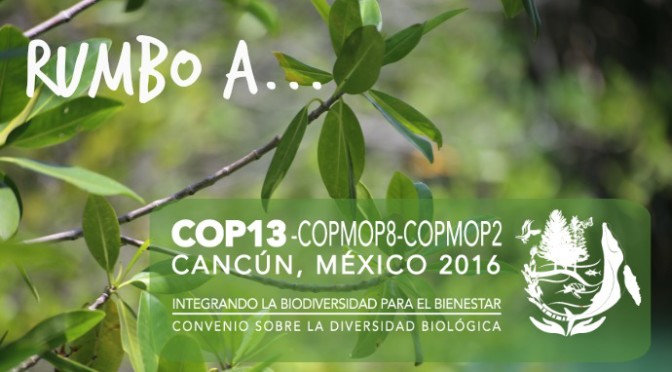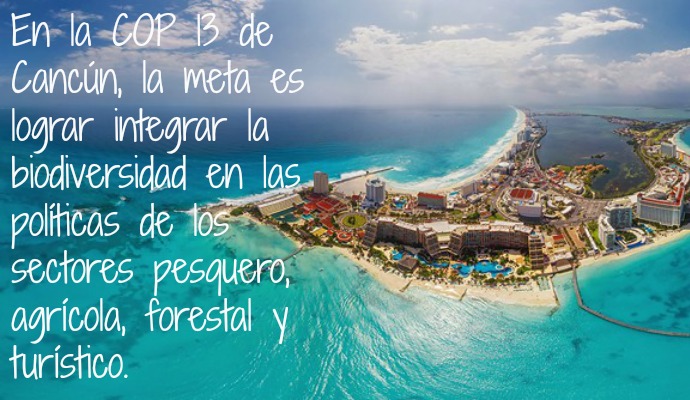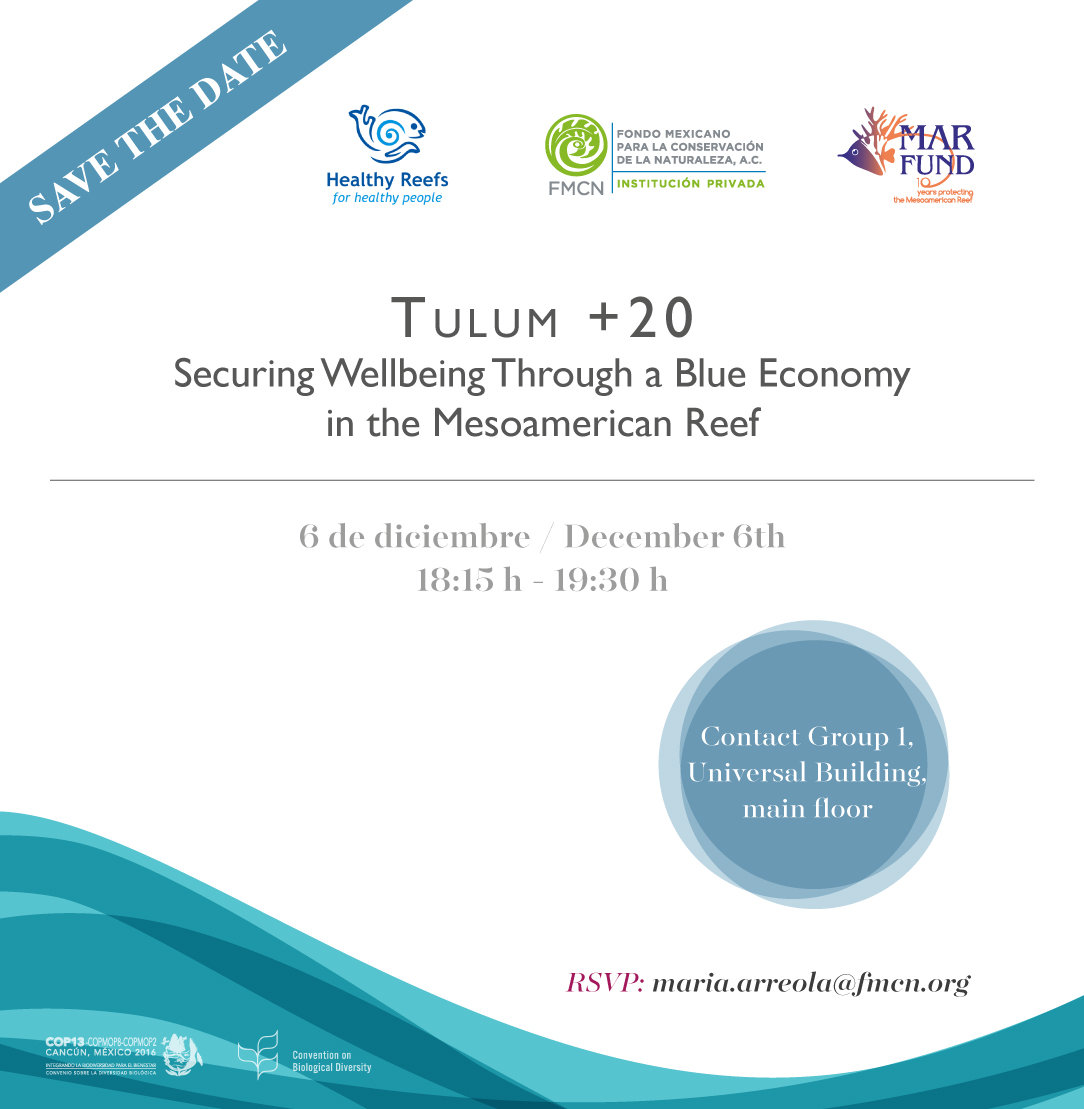But … What is COP 13 of CBD?
In 1992, United Nations member countries or parties, as they are also known, met in Rio de Janeiro to discuss environmental and development issues. The meeting was also called Earth Summit and in this context, the Convention on Biological Diversity (CBD) was born. Parties recognized that protecting biodiversity and ecosystem services was one of the priorities for human future and sustainable development.
On this occasion, the Convention on Climate Change (UNFCCC) was also adopted, the last meeting of which was recently held in Marrakesh (COP22), and the Convention to Combat Desertification.
Since then, several Conference of the Parties (COPs) have been held to follow up on the implementation of the CBD. From these meetings, or COP, the Nagoya Protocols on Fair Access to Genetic Resources , and Cartagena on Biosafety, have emerged.
The Thirteenth Meeting of the Convention on Biological Diversity, COP 13, will be held in Cancun this early December.
Why is it important?
Biological diversity directly influences human well-being through goods and services it provides: oxygen, water, food, medicines, raw materials, protection against disasters, among others.
In 2010, during the tenth meeting of the parties in Japan, a strategic plan was adopted, composed of clear objectives to improve participatory planning, address the causes of biodiversity loss, reduce pressures on natural resources and their sustainable use, and how to safeguard ecosystems and their environmental services. These goals are articulated in 20 goals: the Aichi Targets that seek to protect biodiversity and increase the social benefits they provide through the commitment of member countries and the impact on public policies.
COP 13 will include “Mainstreaming Biodiversity for Well being”, where more than 10,000 participants will work sharing knowledge and negotiate agreements and commitments for the implementation of the Strategic Plan and the Aichi Targets.
This event will emphasize the integration of these targets in the public policies of the countries. Biodiversity conservation and sustainable use will be part of the policies and programs of the different productive sectors that are directly related to the use of biodiversity (agriculture, tourism, fisheries and forestry).
The host country, Mexico, is one of the most diverse countries on the planet, has almost all types of climate, is home to 10% of all species on the planet and has a large coastline on both the Pacific and Atlantic sides. Mexico’s natural diversity is the root of its cultural wealth and a source of opportunities for its communities. These characteristics make Mexico, and Cancún in particular, an ideal place to undertake ambitious programs and take firm positions.
The results of this meeting of the parties need to protect the world’s natural heritage in order to fight poverty and achieve sustainable development goals.
Actions will be expected from participating countries and ratification of their commitments to continue efforts to protect nature for future generations.
What will the MAR Leadership Program and the Mexican Fund for Nature Conservation do during COP 13?
Mexican Fund for the Conservation of Nature A.C. (FMCN) and the MAR Leadership Program will take advantage on the numerous participation of representatives from countries, civil society organizations and business people to communicate their visions and missions in Mexico and the Mesoamerican Reef System (MAR) region.
FMCN will be present in more than 10 events inside and outside the security range of COP 13. In addition, the MAR Leadership Team has been organizing special events: the analysis of blue carbon integration opportunities in Mexican public policy will be presented and the ratification of the Declaration of Tulum, focused on conservation of the MAR will be foreseen. Both topics are explained below.
Write on your agenda:
Monday, December 5, at 15:30 hrs will be held the event Tulum +20 Declaration for the Mesoamerican Reef: Well-being and blue economy at the Cancun Convention Center. This event seeks to disseminate the conservation efforts undertaken in the MBRS region by the different organizations in Honduras, Guatemala, Belize and Mexico. This event is co-organized by MAR Fund, Healthy Reefs Initiative and FMCM / SAM Leadership.
Tuesday, December 6, 8: 30-14: 00 hrs, Coba Hall of the Cancun International Convention Center: Parallel event Public Forum on the integration of the Blue Carbon in the actions of conservation and sustainable development. The event is being organized by the Mexican Fund for the Conservation of Nature (FMCN) and the Mexican Center for Environmental Law (CEMDA) with the support of SEMARNAT and CONANP. It will consist of three panels: an initial one with the Secretary of the Environment of Mexico, Rafael Pacchiano, Gustavo Alanís (Director of CEMDA) and Lorenzo Rosenzweig (Director of FMCN), and two panel discussions with national and international speakers. The first will discuss how the concept of blue carbon can be a link between the conventions of the CBD and the UNFCCC, and in the second, there will be case studies where tools for the successful integration of blue carbon into public policy . At the end of the event, a blue carbon video will be screened, funded by the North American Commission on Environmental Cooperation.
Tuesday, December 6, 6:15 pm, in the Contact Group Lounge 1, Universal Building of the Moon Palace Hotel: Official Tulum Event + 20. The FMCN, MARFund and Healthy Reef Initiative organizations are working together to ensure that representatives of the four countries of the Mesoamerican Reef System Honduras, Guatemala, Belize and Mexico endorse their commitments to the conservation of the world’s largest transboundary reef system. Ratification of the Tulum Declaration will consolidate the efforts and initiatives undertaken in the region.
What is blue carbon?
Blue carbon is carbon captured from the atmosphere (CO2) and stored by marine-coastal ecosystems such as mangroves, marshes and grasslands. Studies carried out in these environments show that the amount of carbon stored in their soils is much higher than the carbon fixed by terrestrial environments: although they cover 0.5% of the seabed, they capture almost half of the CO2 emissions of transportation.
In addition to carbon capture, mangroves, seagrass and marshes play a very important ecosystem role: they are a barrier against storms, they are places of reproduction and breeding of a high biodiversity, source of food for coastal communities, and reserve Of biochemical compounds used in pharmacology, etc.
There are already several financial mechanisms in land-based forests to promote and promote their conservation based on the ecosystem-based carbon sequestration ecosystem service to mitigate the effects of climate change.
For coastal ecosystems, these mechanisms are little known.
Opportunities to integrate blue carbon into public policy will be presented at the parallel event organized by FMCN and CEMDA (Mexican Center for Environmental Law). Case studies and experiences of international experts from the public, private and civil society sectors will be shared.
This event will take place at the Cancun Convention Center, on Tuesday, December 6 from 8:30 in the morning, it is open to the general public so do not miss it!
What is the Tulum Declaration?
In 1997, in celebration of World Environment Day in Tulum, representatives of the four countries of the Mesoamerican Reef (MAR), Honduras, Guatemala, Belize and Honduras officially recognized the value of their shared marine-coastal ecosystems and the importance of its conservation for the well-being of future generations.
Countries, aware of the many ecosystem services offered by the MAR, decided to commit to promoting their protection through cooperation programs and the elaboration of an Action Plan.
This Plan mainly seeks to:
– Support the inclusion of marine-coastal ecosystems in the Mesoamerican Biological Corridor Project.
– Promote scientific research and environmental education to reduce impacts by creating awareness and knowledge.
– Strengthen financial mechanisms and seek new economic tools for conservation programs.
See the Tulum Declaration here.
Almost 20 years after its signature, the Tulum Declaration has made many efforts and cooperation initiatives implemented. However, faced with new challenges such as climate change, these programs need to be strengthened and ensure their permanence.
Some organizations that are working on SAM regional programs such as SAM-FMCN Leadership, MARFund and Healthy Reefs Initiative have joined efforts to motivate representatives of governments of SAM countries to endorse the commitments made 20 years ago and continue to protect this Valuable ecosystem and the communities that depend on it.







